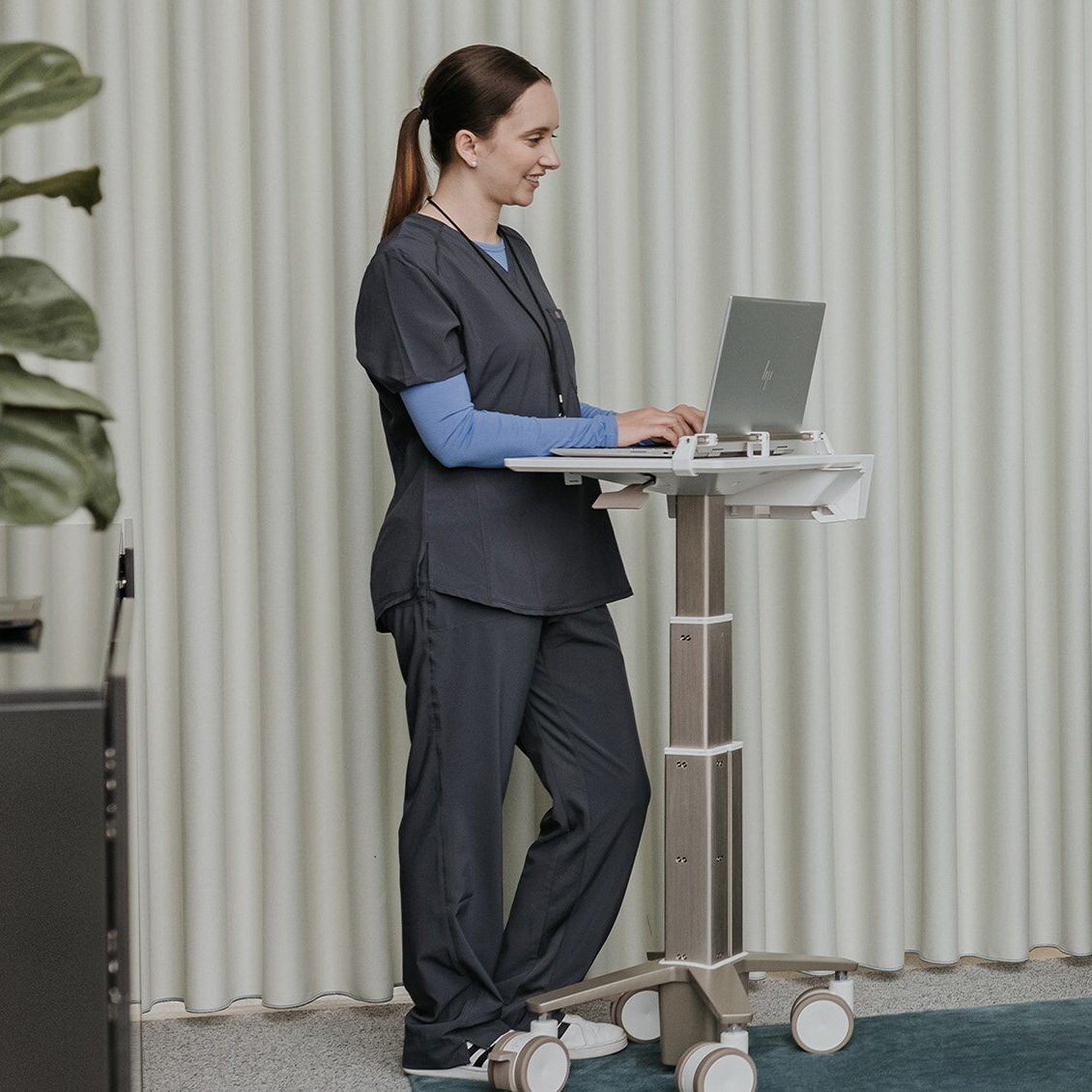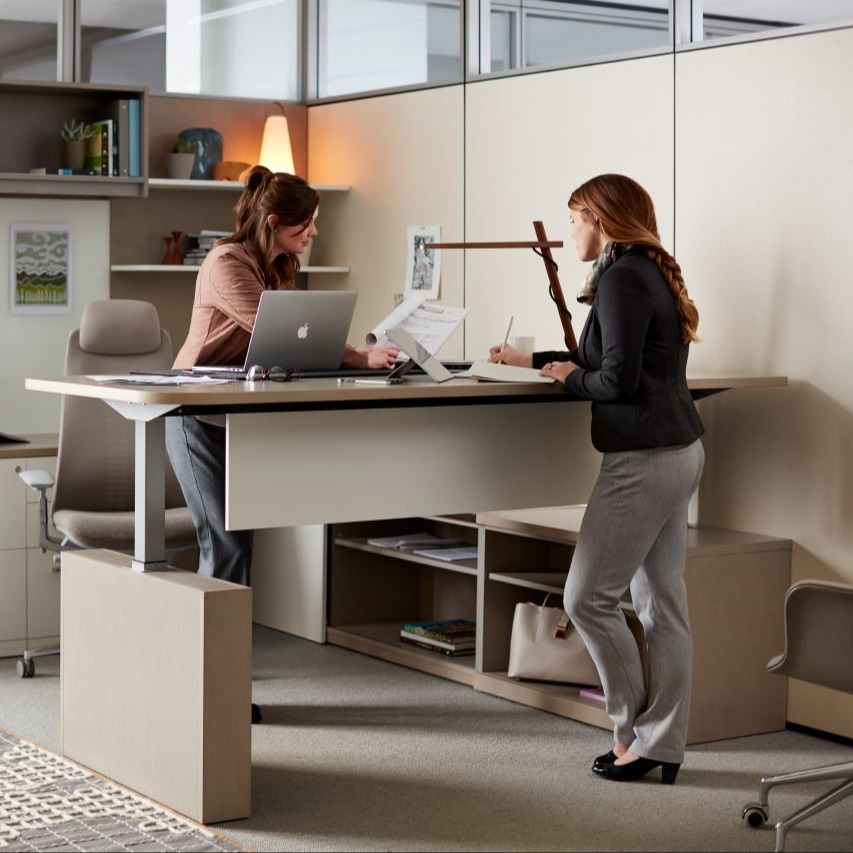Create a workplace where people want to spend time
A productive, comfortable, and enjoyable work environment starts with the right furniture. Whether you are looking to grab the attention of visitors at your reception area or provide a more ergonomically healthy space for your team, you need a solution that fits your unique situation.
Featured Products
What Should You Look for When Selecting Office Furniture?
When selecting office furniture, prioritize ergonomics and comfort to support team well-being, durability and quality materials for long-term value, and functionality and flexibility to fit evolving workspace needs. Also consider your available space, budget, and the aesthetics that reflect your office style.
Here is a short snapshot to get you thinking.
Schedule a Consultation 7 Success Factors for Office Furniture Selection-
Does this furniture have the ergonomic features we need?
-
Is it adjustable or flexible?
-
Is it multi-functional or reconfigurable?
-
How will this furniture affect the wellness of our team?
-
Does it match our office’s aesthetic?
-
How good is the warranty?
-
How reputable is the brand?
How Do You Determine the Best Office Furniture Provider for Your Project?
Evaluate providers based on measurable customer service, local support & installation, custom design capabilities, transparent budget discussions, and reliable brand partnerships. Also look for full service offerings, community trust/reputation, and flexible financing options.
We asked our customers and came up with these seven factors that you should look for in an office furniture dealership.
- Measurable Customer Service
- Custom Design Capabilities
- Discusses Budget Early
- Carries Reputable Brands
- Full-Service Offering
- Strong Values
- Giving Back
Ultimately, the office furniture dealer that will provide you with the best experience (and product) will be the one that can connect with the values you want your space to demonstrate to your team.
We know that finding the right office furniture dealer can feel overwhelming. To make life easier, we’ve rounded up some of the top office furniture dealers in Atlantic Canada so you can compare options quickly and make an informed decision.
In Our Customers’ Own Words
"Fast delivery, very courteous staff and quickly put the units together. Would recommend Office Interiors to anyone looking for good quality furniture and awesome customer service."
Gina Jones-Wilson, President, Upper Hammonds Plains Community Development Association
What Does Office Furniture Cost?
The cost of office furniture can vary widely depending on quality, features, and finishes. On average, ergonomic task chairs range from $450 to $1,300, while desks and work surfaces such as a 6’ × 6’ L-shaped desk typically fall between $900 and $7,000. For complete workstations or systems furniture, businesses should expect to budget about $1,800 to $5,000 per workstation. Final pricing depends heavily on storage options, material selections, and ergonomic adjustments, but these ranges give a realistic idea of what to expect when budgeting for a new office.

How Long Does It Take to Order and Receive Office Furniture?
All in all, you should expect it to take between 7-10 weeks to buy office furniture from the first conversation with an Account Manager until your furniture is fully installed.
If trying to estimate how long it will take to receive your furniture from the date you placed your order, you should budget 5-7 weeks.
Keep in mind that this timeline can stretch longer depending on customization, special finishes, overseas manufacturing, and scheduling constraints.
Let’s take a closer look at where those ranges come from and exactly how long each stage in the process should take.
Read the Full Ordering Timeline Learn How Long Installation Takes-
Product Selection: Highly variable; depends on how quickly you choose finishes, fabrics, and models.
-
Drawings & Layout Revisions: ~1–2 days per revision (can stretch if multiple rounds are needed).
-
Quoting & Budget Approvals: Usually 1–5 business days, depending on scope and complexity.
-
Manufacturer Lead Times: On average 4–6 weeks for most commercial-grade furniture. Custom finishes or specialty items may take longer.
-
Shipping & Delivery: Typically included in the manufacturer’s lead time (part of the 5–7 week window).
-
Installation: Usually 1–5 days, depending on office size and complexity of the setup.
Project Categories
K-12 and Higher Education
Our education team understands the unique requirements needed to create a successful learning environment. With access to a wide range of innovative furniture solutions, we design spaces that encourage collaboration, support student engagement, and foster meaningful interaction between students and educators.
We also recognize the intricacies of working within the K-12 sector and make procurement simple by offering provincial and federal purchasing contracts. This means you can rely on us to deliver cost-effective, purpose-built learning spaces tailored to your school’s needs.
.png?quality=low&width=1080&height=1080&name=Headshots%20-%20Cabco%20%26%20L.E%20(1).png)
Healthcare
We partner with leading healthcare furniture manufacturers to deliver products and services tailored for private practices, hospitals, medical offices, clinics, and long-term care facilities. Our solutions are designed to meet the unique needs of healthcare environments while keeping your budget in mind.
We also help maximize value by contributing many of your purchases toward Group Purchasing Organization (GPO) programs such as Kinetic GPO and the Canoe Procurement Group of Canada. Combined with our facility services, this makes Office Interiors a single-source supplier for healthcare clients across Atlantic Canada.

Corporate
From small-to-medium-sized businesses working within a tight budget to corporate clients serving a global audience, no project is too complex for our team of highly qualified professionals. By taking the time to understand your needs, we create tailored office solutions that support the way you work. The results? Workplaces that empower your company to innovate freely, strengthen customer relationships, and attract top talent.

Government
Our experienced government team offers procurement resources that provide government customers best value and simplified procurement through the most responsive product and service programs available. We offer a significant past performance resume in local, provincial and federal government work for quality products and exceptional service.

Office Furniture Partners We Work With
Office Interiors is a proud Haworth Best In Class Dealer.
We also partner with 50+ industry-leading manufacturers to offer an array of products that exceed the needs of any project.
Together, we work seamlessly to create inspirational spaces where people thrive.













View Our Government Supply Arrangements
Furniture procurement is complex, we make it simple. As a trusted supplier under multiple provincial, federal, and group purchasing contracts, we help organizations get the products, services, and solutions they need faster, easier, and with full compliance.
Whether you're equipping a new office space or upgrading existing infrastructure, we provide seamless access to furniture, technology, interiors, communication systems, and more through pre-qualified supply arrangements.
FAQs
What’s the difference between commercial-grade office furniture and retail furniture from IKEA or Staples?
Commercial-grade office furniture is engineered for durability, customization, and high daily use, whereas retail / “residential-grade” furniture (like IKEA or Staples) is built for lighter use, limited options, and lower cost. Commercial pieces come with stronger warranties, customizable finishes, higher quality materials, and are designed to endure heavy traffic over many years. Learn more.
Do I need a dealer, or can I buy directly from manufacturers?
While you can order directly from manufacturers, working with a knowledgeable local furniture dealer adds significant value. Dealers give you access to exclusive brands, full customization options (finishes, fabrics, configurations), and handle project services like space planning, procurement, and coordination. They also manage deliveries, trained installations, and long-term support so you don’t have to become a logistics expert. Learn more.
How much office space do I need?
The amount of office space you need depends on your layout, company culture, and type of work. On average, businesses allocate 150–175 sq. ft. per employee, though this varies: private offices range from 120–400 sq. ft., collaborative areas need 30–50 sq. ft. per person, and conference rooms average 25–30 sq. ft. per seat. Shared spaces like reception, break rooms, and support areas like storage or server rooms typically account for 20–30% of total office space.
What makes office furniture ergonomic?
Ergonomic office furniture is designed to support the body’s natural posture and reduce strain during long hours of work. Key features include adjustable seat height and lumbar support in chairs, sit-stand desks for posture changes, and accessories like monitor arms or keyboard trays that align workstations to the user. The goal is to improve comfort, reduce injury risks, and increase productivity. Learn more.
How do I pick the right furniture for a small office / maximize my office footprint?
In smaller offices, maximizing footprint starts with choosing multifunctional and modular furniture such as nesting chairs, mobile tables, or desks with integrated storage. Vertical storage solutions like shelves and wall-mounted units free up floor space, while smart desk placement against walls or near windows creates better flow. By combining compact, flexible furniture with efficient layout planning, even small offices can feel open, functional, and productive. Learn more.
Looking to Speak With an Office Furniture Expert to Discuss Your Project?
Fill out the form on the right and we'll get back to you within the same day.
Our team has helped thousands of businesses from across Atlantic Canada create productive work environments and would be more than happy to answer any questions you may have, just reach out and ask!



